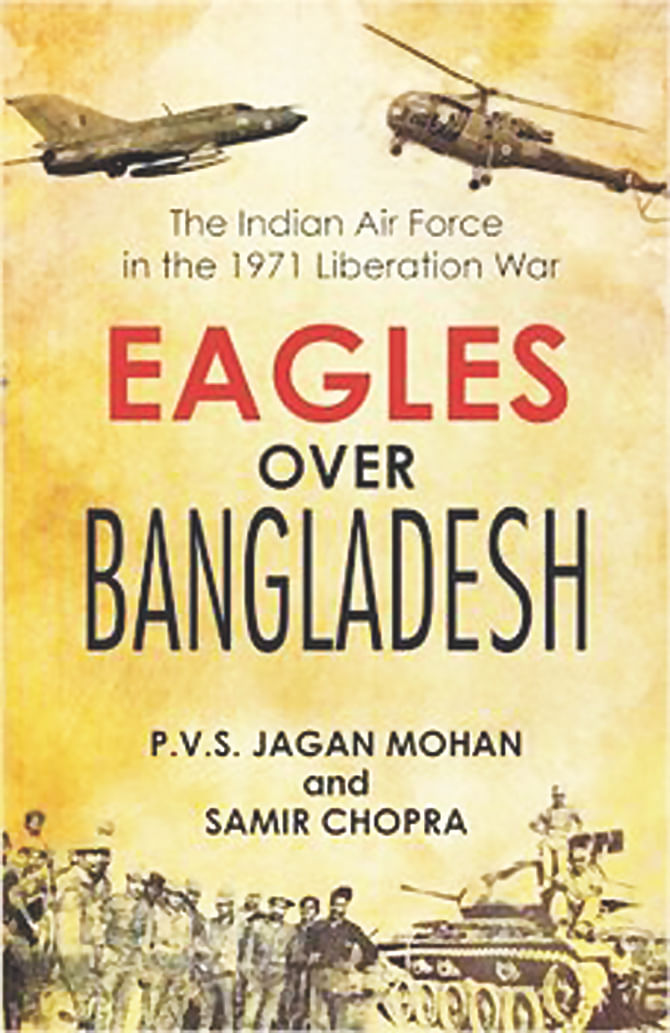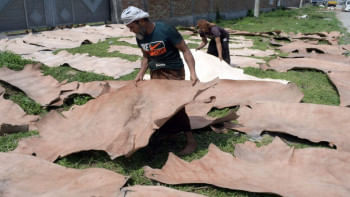Firestorm from the Air

If there was one thing that was clear on 16th December 1971, when Lt Gen A.A.K. Niazi signed the instrument of surrender alongside Lt Gen J S Aurora, it was that the outcome of the Pakistani yolk being shed was never in doubt. It was only a matter of when and how soon it would happen. Every major player in the war on the allied side, whether the Mukti Bahini, or the Indian Army could have single-handedly liberated Bangladesh from the brutal regime of the Pakistani government. It would have taken them longer of course but by combining forces they accomplished something in about a fortnight. Assisting them along the way was the Indian Air Force and its massive array of weaponry that it deployed against the West Pakistani ground forces in the East.
The Air war
Many books and articles have been written about the war in the air from all sides that took part in the war. The air war started with an opening volley on November 22nd, when the battle for Garibpur was taking place near Boyra. A formation of their PAF F-86 Sabres was intercepted by Indian Gnats and two Sabres were shot down - and a third being damaged. When hostilities came out in the open on December 3rd with the premptive strike by the PAF on Indian Air Fields in the West, all gloves were off as the Indian and Bangladeshi forces opened the Eastern front.
The air war in the east started with a massive effort by the IAF squadrons in trying to destroy the Pakistani Sabre force at Tejgaon. The Pakistanis judicious use of radar and their aircraft - in not taking up battle against overwhelming numbers paid some dividends. By end of the day the IAF could account for only three of the Sabres. Another ten Sabres were still unaccounted for and were intact. While the PAF itself didn't have much of an impact on the IAF losses (only two were lost in the air combat), the Pakistani Army's AA Guns were more potent - claming three aircraft near Dacca and two other aircraft elsewhere.
The IAF quickly caught on to the PAF game plan and in an ever changing battle environment quickly changed tactics. Previously unused Russian bombs were combined with new tactics and by the morning of December 6th, the Runway at Tejgaon was permanently cratered. All the remaining Pakistani Sabres were now stuck on the ground and would fall into allied hands after the surrender. Two of these Sabre fighters can still be seen in BAF airfields.
On the subsequent days the IAF had a free hand - in flying support missions for the Indian Army. Pakistani Army formations were strafed, bombed, rocketed on call. They were harassed by day and night, wearing down their morale and strength. Day after day the sorties were flown against ground positions, transportation and one special day all the riverine traffic supporting the Pakistani army effort was targeted.
There are many memorable 'battles' that happened during the air campaign. The air combats over Dacca , the accurate bombing of the runways at Tejgaon and Kurmitola, the surgical strike on Governor House that forced the Governor Malek's regime to resign, and the constant suppression of the Pak Army strongholds in the university to name a few.
In the whole of the war, the Indian Air Force flew over 2000 combat sorties - and dropped approximately 1250 bombs, fire 12,600 air to ground rockets and expended 1,35,000 cannon shells.
No wonder - on the day of surrender General Niazi admitted to an IAF Officer that it was the IAF that kept him up in the night - denying him much needed sleep and always maintaining the pressure.
Local Populace Support
Such an effort by the IAF did have a few tragical consequences - collateral damage when bombs fell on civilian areas. The Bengali civilian population did suffer incidents where causalities occurred - the bombing of Adamjee Jute Mills on the morning of December 4th, and the bombing of the Orphanage at Tejgaon are two incidents that stand out. Yet if there was one thing the Indian Air Force pilots could count on, it was the support of the local populace. In the eyes of the Bengali populace they could do no wrong. And when the situation occurred that they had to parachute down in East Pakistani territory, they were looked after well.
For example, on December 4th, 1971 approx 8.00 am local time about 30 miles west of Dhaka. Screaming just a few hundred feet over the wet paddy fields was an Indian Air Force Hunter Jet fighter trailing smoke and fire, being chased by a Pakistani Sabre jet with all guns blazing, scoring hits on the stricken enemy aircraft. As the Indian jet seemingly lost height and began its path to destruction, the pilot made a split second decision to pull the ejection handle. Within seconds, and possibly few feet from certain death, the pilot descended under a parachute and landed in a paddy field - badly injured - lacerations on his face and a broken arm. In the context of the India Pakistani battles, ejecting over the enemy country is fraught with danger - with possibility of lynching by villagers and hostile populace.
But for this Indian pilot, Squadron Leader Kanwal De Mehra, lying helpless in the field still tied to his parachute, he need not have worried. The villagers who reached him first, though citizens of the country he just bombed were actually his saviours. One of the villagers, Shojib, took charge of the wounded air warrior and ensured that he was transported over the next few days to Indian controlled territory without harm avoiding Pakistani Army patrols hunting for the downed pilot.
If the above incident tells a story - it is that the Indian Air Force Pilots who were flying over East Pakistani flew with such impunity and sense of safety that wouldn't be mistaken if the territory below them felt to be their own. The people on the ground, who just six years ago would have looked up in dismay at the 'enemy' now cheered and supported the 'friends from the air'.
The IAF reigned supreme over the skies pounding the Pakistani army into submission, but also suffered losses - like Mehra's Hunter, they were backed by the civilian populace of East Pakistan who were the victims of the brutal west Pakistani regime. So when another pilot, Squadron Leader K J S Gill ejected miles from the Indian border, he was rescued by the Mukti Bahini and was transported to Agartala. And so was Flt Lt L H Dixon who ejected near Hilli. The Mukti Bahini arrived and took charge of him before the Pakistanis could. In some tragic incidents when Sqn Ldr Ramesh Sachdeva died ejecting from his stricken Hunter, it was the Mukti Bahini fighters who pulled Sachdevas body from the water and took care of him till the Indian Army arrived. And on the last day of air operations a Canberra was shot down near Kurmitola killing both the crew - Pilot Brian Wilson and Navigator Flt Lt R B Mehta. Local villagers recovered their remains and buried them in marked graves.
Visiting Indian pilots who landed in Dhaka days after the surrender were treated as VIPs and celebrated as heroes by locals. At the same time many of the Indian pilots were aware of the tribulations that the locals had undergone. Some of them have seen the refugee camps that were set up ahead of the war in India. There was no doubt that they were fighting for a just cause.
Only in one situation that an Indian pilot had to eject and landed near an area where the Bihari Muslim population was dominant. And he suffered physical and mental abuse in their hands for the first few minutes till he was taken prisoner by the Police. At the same time it should be mentioned that the Bengali populace were not so receptive to the two known Pakistani fliers who ejected after air battles over Dhaka. Both the Pakistani pilots have never been heard from again.
The “Enemy Air Force”
It is no secret that the Pakistani Air Force presence in East Pakistan/Bangladesh was limited to one single Squadron of F-86 Sabre fighters and some ancillary units including a few helicopters and impressed civilian light aircraft. Right from the start there was no expectation that this squadron would last more than a couple of days. And true enough, the overwhelming superiority of the Indian Air Force - 12 Squadrons of combat aircraft, its relentless focus on Dhaka and its airfields and the superior employment of its weapons - especially the 500kg Russian bombs employed by the MiG-21s ensured that by the third day, the runways at Tejgaon were badly cratered, permanently grounding the Pakistani fighter force. The IAF kept the pressure up on subsequent days by bombing the airfield almost every day. The runways were so badly damaged that it took days after the surrender for it to be repaired enough to allow use by heavy transport aircraft.
The Pakistani Air Force squadron and its pilots, in its short period of existence achieved some partial objectives. It kept the IAF engaged heavily on the first day. While they were able to disrupt the IAF raids from achieving the objectives, their direct impact in terms of aircraft shot down was very limited. In the numerous air battles over Dacca, they accounted for only two Indian aircraft shot down, while losing three of their own.
The “Kilo Flight” and their Indian Air Force Comrade in arms
No story of the Air War over Bangladesh would be complete without the mention of the Kilo Flight - the predecessor for the Bangladesh Air Force. Established by the efforts of then Gp Capt A K Khandoker, and with ample support from the Indian Air Chief Marshal P C Lal, the Kilo Flight consisted of nine Bengali pilots - three from the PAF and six from the PIA and other civil agencies. Equipped with an Alouette helicopter, a DHC 3 Otter aircraft and a Dakota transport, the flight made a symbolic contribution to the Air War, by flying the very first missions over the skies of East Pakistan in the early hours of December 4th.
Watching proudly as these fledgling warriors were taking to the skies were the Indian instructors who had spent weeks with them providing training - Gp Capt Chandan Singh, Sqn Ldr Ghoshal, Sqn Ldr Sanjay Kumar Choudhary and Flt Lt C M Singla.
It is no wonder that the Indian Air Force shares a sense of achievement for having taken a key part in raising the Kilo Flight. And the BAF had reciprocated these relations in recent years. And to keep the connections live, the IAF had gifted vintage aircraft to the BAF Museum for years. with the latest being a rare WW2 era Dakota aircraft that was handed over the BAF chief in September 2014 , and recently transported by air to Dhaka in an IAF C-17 aircraft. The Dakota, along with its earlier brethren would stand testament to the strong partnership the IAF and BAF showed in the liberation war - 43 years ago.
The writer is an aviation historian from India. He has recently co-authored a book on air operations in the Bangladesh War titled 'Eagles over Bangladesh', published by Harper Collins India.

 For all latest news, follow The Daily Star's Google News channel.
For all latest news, follow The Daily Star's Google News channel. 



Comments